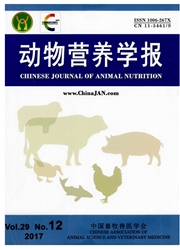

 中文摘要:
中文摘要:
本试验旨在研究不同蛋白质源饲粮对肉牛能氮代谢和甲烷排放的影响.试验选用3头健康状况良好,体重接近并装有永久性瘤胃瘘管的宣汉黄牛,采用3×3完全拉丁方设计.试验饲粮分别以豆粕、菜籽粕、棉籽粕为蛋白质源进行配制;试验分3期,每期20 d,其中预试期10 d,消化试验3d,呼吸代谢试验7d.结果表明:1)各试验组的总挥发性脂肪酸浓度差异不显著(P>0.05),豆粕组和菜籽粕组的乙酸浓度显著高于棉籽粕组(P<0.05),菜籽粕组和棉籽粕组的丙酸浓度显著高于豆粕组(P<0.05),3组丁酸浓度差异显著(P<0.05),各组乙酸/丙酸差异显著(P<0.05),为豆粕组>菜籽粕组>棉籽粕组;各组氨态氮含量差异显著(P<0.05),为豆粕组>棉籽粕组>菜籽粕组.2)豆粕组、棉籽粕组、菜籽粕组的采食氮、粪氮、可消化氮以及氮消化率差异都不显著(P>0.05);尿氮则是豆粕组和棉籽粕组显著高于菜籽粕组(P<0.05),沉积氮和氮利用率则是菜籽粕组显著高于豆粕组和棉籽粕组(P<0.05).3)3组尿能差异显著(P<0.05),为豆粕组>棉籽粕组>菜籽粕组,豆粕组的增重净能、增重净能/总能、增重净能/消化能和增重净能/代谢能均显著低于菜籽粕组和棉籽粕组(P<0.05).4)3组甲烷排放量、甲烷能和甲烷能/总能以及每千克干物质采食量的甲烷排放量差异均显著(P<0.05),均为豆粕组>菜籽粕组>棉籽粕组.综上所述,以菜籽粕为蛋白质源的饲粮氮生物学效价最高,豆粕次之,棉籽粕最低;以棉籽粕为蛋白质源的饲粮增重净能最高,菜籽粕次之,豆粕最低;以豆粕为蛋白质源的饲粮的甲烷排放量最高,菜籽粕次之,棉籽粕最低.
 英文摘要:
英文摘要:
This study was conducted to study the effects of different dietary protein sources on energy and nitrogen metabolism and methane emission of beef cattle.Three healthy Xuanhan Yellow cattle with similar body weight fitted with permanent ruminal cannulas were used in a 3×3 complete Latin square design.Soybean meal,rapeseed meal and cottonseed meal were used as protein sources to prepare experimental diets; the experiment was consisted of 3 periods with 20 days in each period (pre-experimental period:10 days; digestion experiment:3 days; breath metabolism experiment:7 days).The results showed as follows:1) total volatile fatty acid concentration in experimental groups was not significantly different (P>0.05); acetate concentration in soybean meal and rapeseed meal groups was significantly higher than that in cottonseed meal group (P<0.05) ; propionate concentration in rapeseed meal and cottonseed meal groups was significantly higher than that in soybean meal group (P<0.05) ; butyrate concentration in three groups was significantly different (P<0.05) ; acetate/propionate in three groups was significantly different (P<0.05),and the order was soybean meal group>rapeseed meal group>cottonseed meal group; NH3-N content in three groups was significantly different (P<0.05),and the order was soybean meal group>rapeseed meal group > cottonseed meal group.2) Nitrogen intake,fecal nitrogen,digestible nitrogen and nitrogen digestibility in three groups were not significant different (P>0.05) ; urinary nitrogen in soybean meal and cottonseed meal groups was significantly higher than that in rapeseed meal group (P< 0.05),and nitrogen deposition and nitrogen utilization in rapeseed meal group were significantly higher than those in soybean meal and cottonseed meal groups (P<0.05).3) Urinary energy in three groups was significantly different (P<0.05),and the order was soybean meal group>cottonseed group meal>rapeseed meal group; net energy fo
 同期刊论文项目
同期刊论文项目
 同项目期刊论文
同项目期刊论文
 期刊信息
期刊信息
